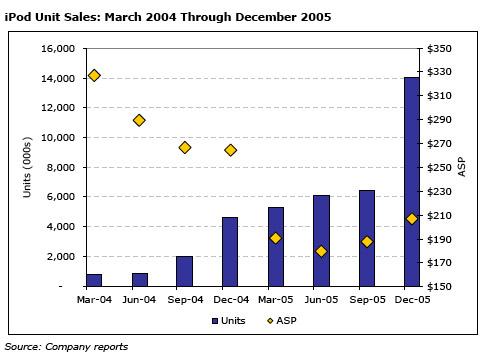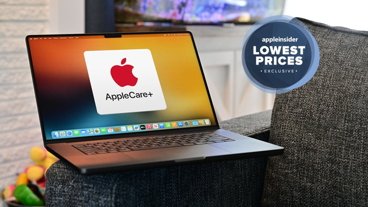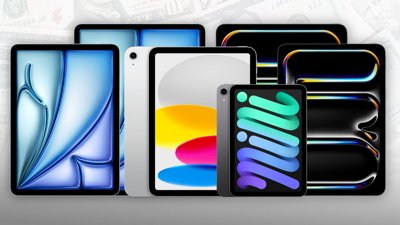Apple following iPod, PS2 model to sell 23m iPhones in one year
In a research note, Pacific Crest's Andy Hargreaves notes that both the iPod mini and the PlayStation 2 both saw "massive acceleration" when their prices dipped below $200 for the first time, selling several times the amount they'd managed the year before.
For Apple, the change saw iPod sales grow from selling 8.3 million of the players in one year to 32 million — or nearly four times more. If Apple's estimated six million iPhones sold in the past year matches that same change in growth rate, the Cupertino, Calif.-based company would sell over 23 million iPhones by June 2009.
"The relationship [between price and sales] is shockingly consistent," Hargreaves says. "At average prices above $200, Apple never sold more than [6 million] units in a rolling four-quarter period. At prices below $200, Apple never sold fewer than [8 million]."
The analyst also explains that this doesn't take into account the wildcard of free iPhones and heavier discounts in Germany, the UK, and other countries, which could add "several million" more iPhones to sales for every quarter and overcome rivals like Nokia, whose N95 is often given away with many plans.
The iPod's surge in sales after price drops.
Even on the more modest curve on Sony's PlayStation 2 console, the iPhone is likely to sell many more units, according to the report. When the Japanese electronics giant slashed the PS2's price to $199 in May 2002, it not only reversed a drop in sales but saw Sony's monthly sales jump 61 percent on average. A similar change would give Apple a still significant 17 million iPhone sales in 12 months.
Pacific Crest's researcher further suggests that Apple is generating more money per iPhone than already high estimates: an early prediction would have AT&T alone subsidizing as much as $350 of the cost of an iPhone to reach the $199 price point.
Regardless of Apple's income per phone, the company is also thought to have momentum on its side by launching earlier than phones based on Google's Android as well as very similar touchscreen phones from other rivals.
"We believe Apple has already established its brand as a premium name in the space, and the company appears to be continuing its recent history of introducing revolutionary products," Hargreaves asserts. "This combination should allow it to maintain a leadership position and mitigate the margin pressure that can come with increased competition."
 Katie Marsal
Katie Marsal













 Malcolm Owen
Malcolm Owen

 Amber Neely
Amber Neely

 Marko Zivkovic
Marko Zivkovic
 David Schloss
David Schloss
 Wesley Hilliard
Wesley Hilliard
 Mike Wuerthele and Malcolm Owen
Mike Wuerthele and Malcolm Owen









35 Comments
Ooh Am I first?
I'm still sticking to my prediction of 60 million total sold by end 2009
Ok, now this is getting ridiculous -- every analyst seems to feel a need to top the last one on how many iphones Apple will sell. Well, I'm going to win this little pissing contest; I think Apple is going to sell 43 trillion iPhones. There, I said it. now you can all shut up and stop ensuring that the stock price will tank at every quarterly report for the next 20 years, despite solid 2-digit growth.
The most significant difference between the iPod/PS2 and here is that the iPhone comes with $70+ monthly plan for two years.
Still, though, that $199 price point is a big, big deal. They will sell many iPhones in '08 - easily over 10M. And once a ultra-thin, lightweight iPhone nano comes out ('09?), they will *really* do well.
It's all a function of how many they have produced. If you figure there was a 3-month production ramp at an average of 2MM phone's per month, they should have good supply for the re-launch. Because of the lost months of sales though, they really have a lot of catch-up to do, so I am really hoping they maintain good stock levels everywhere.
If all the stars are in alignment, I can easily imagine 20MM units in the last half of the year.
ok all this celebrating higher and higher sales, the extra cost of the plans has to have some influence, but if other smartphones have the same extra cellular cost then maybe....but why the stock price is down down down......what's this sell on good buy on bad news. i would have expected the stock price to be over 200 not 175. what do the analysts say about this....
so it doens't make sense, maybe when these numbers start coming in will the stock price come up
also i can't wait for the apps store to open that will be another indicator.
also, these analysts don't have any accountability they can say a billion and what lose their jobs? no because its about reading the story next to the ads selling right next to the story
why even list this anyway, why don't we just post updated numbers
here's mine
50 million by the end of 2008 because they will have a iphone nano and announce a $100, price point now give me a raise.
now don't fire me, its my analyst part of me saying this.